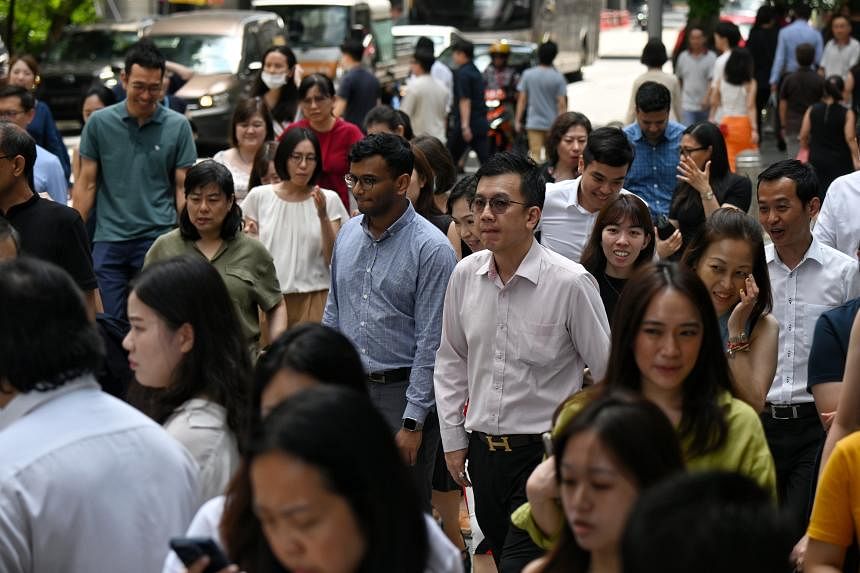SINGAPORE – Several training and workforce measures were introduced in the Budget on Feb 16.
They include a monthly training allowance for mid-career Singaporeans aged 40 and above pursuing selected longer full-time courses from 2025.
Everyone in that age group will receive a $4,000 SkillsFuture Credit top-up as well from May 2024, albeit for use with selected training programmes with better employability outcomes.
A temporary financial support scheme for involuntarily unemployed Singaporeans is also set to come.
Prime Minister Lee Hsien Loong unveiled the support scheme in the 2023 National Day Rally, noting that it will enable those who are laid off to attend skills courses rather than seizing whatever jobs are offered out of desperation.
The Straits Times takes a closer look at support for unemployed people.
Q: What does involuntary unemployment mean?
A: Involuntary unemployment generally refers to the loss of a worker’s job through employer actions to retrench staff or not renew employment contracts, and is not attributed to the worker’s actions, said Associate Professor Walter Theseira of the Singapore University of Social Sciences.
Retrenched workers are a subset of involuntarily employed workers, added Associate Professor (Practice) Terence Ho of the Lee Kuan Yew School of Public Policy.
The involuntarily unemployed also includes job seekers who have entered or re-entered the workforce after their studies, or after having spent time away for family reasons but have not yet found a job, Prof Ho said.
However, Prof Theseira noted that the exact definition of involuntary unemployment for the purposes of the re-employment support scheme remains to be defined by policymakers.
He added that voluntary resignation would usually be excluded.
“Thus, one problem in the Singapore context is the widespread practice of ‘voluntary’ resignations used by both companies and workers to avoid the stigma of firing, or the need to report retrenchments to the Ministry of Manpower,” he said.
Q: What if the re-employment support scheme for involuntarily unemployed Singaporeans overlaps with the SkillsFuture Mid-Career Training Allowance?
A: Eligibility for re-employment support is set to be contingent upon workers pursuing training, or searching for a new job that fits them better.
This means there would be some overlap between the allowance and temporary support scheme, said Prof Theseira.
“It may be that the systems are stackable, in that everyone gets a basic entitlement, but there are additional incentives or allowances based on specific training schemes,” he said.
Prof Ho said: “The two forms of support may coincide for involuntarily employed Singaporeans aged 40 and above who take up the SkillsFuture training allowance.”
In such a case, the Government’s financial support would need to be rationalised across the two schemes, he said.
Prof Ho also said the support scheme will likely be broader, and not limited to those aged 40 and above who are pursuing full-time training.
“For instance, some of the involuntarily unemployed workers may take part-time training or shorter courses to refresh their skills for new jobs,” he added.
Prof Theseira said the extent of overlap would also depend on the living expenses used to derive the amount paid by the support scheme.
It also remains to be seen how the differences in payouts from other sources, such as from the training allowance, would affect the amount disbursed by the support scheme, he noted.
A recipient could receive a lower training allowance than someone else attending the exact same training, and with similar household expenses, which some workers could perceive as unfair, Prof Theseira noted.
This is because the SkillsFuture allowance is pegged to half of one’s average income in the latest available 12-month period, up to $3,000 a month, for up to 24 months in the individual’s lifetime.
Q: Why are these schemes needed now?
A: The support measures for mid-career workers aim to help those who need a skills reboot and have to take time off work to attend training over an extended period while juggling financial and caregiving obligations, said Deputy Prime Minister Lawrence Wong in his Budget speech.
He also noted that the Government’s move to provide temporary support for this group of workers comes amid technological changes that will bring about more churn in the economy.
So even when the economy as a whole is doing well, some businesses, or even industries, may be suffering, said DPM Wong, adding: “In some sectors, firms will have to let go of people, while in other sectors, new and better jobs will be created.
“We have to accept this reality, but it doesn’t mean we should be indifferent to the suffering caused when firms lay off workers.”
Major employers in the technology and finance sectors, including Meta, Google and Lazada, laid off scores of workers here in recent years to gain agility while reducing costs.
Retrenchments in Singapore more than doubled in 2023 from the previous year to 14,320, even as the overall unemployment rate fell slightly.
Total employment growth here for 2023 slowed amid weaker economic conditions, following a sharp post-pandemic rebound in 2022.
Preliminary Ministry of Manpower estimates on Jan 31 noted that a more muted pace of growth was seen for both residents and non-residents.
Those who become involuntarily unemployed naturally feel the pressure to rush into the first available job they find, even if it is not a good fit, to make ends meet, DPM Wong said. Ideally, however, they should upgrade their skills and find a job that fits their aptitude and talent.
Q: Is the training allowance a form of unemployment benefits?
A: Many economists do consider training allowances to be functionally equivalent to unemployment benefits, Prof Theseira said.
They are given out in similar circumstances and have similar effects on supporting unemployed workers.
“Indeed, many unemployment benefit schemes actually require workers to look for jobs or undergo training, blurring the lines further,” he said.
“Thus, it comes down to political messaging, as well as some of the finer details of the policy, to make the difference, if any.”
Q: How do other countries support unemployed workers?
A: Those out of work in Britain, searching for a new job and affected by redundancy may qualify for various schemes, depending on individual circumstances.
Universal credit, an allowance to help with living costs, comes up to at least £292.11 (S$497) per month.
The amount changes depending on the person’s age, relationship status, number of children and childcare expenses.
Job seekers can receive a separate allowance of up to £84.80 per week.
People in Taiwan covered by unemployment insurance can receive unemployment benefits amounting to 60 per cent of the salary amount they have insured.
Prof Theseira said that unemployment benefits in place outside Singapore need not be tied to whether the status is “involuntary”.
Instead, the support can be unconditional or tied only to effort made in job seeking or training, rather than how the worker ended up unemployed, he said.


